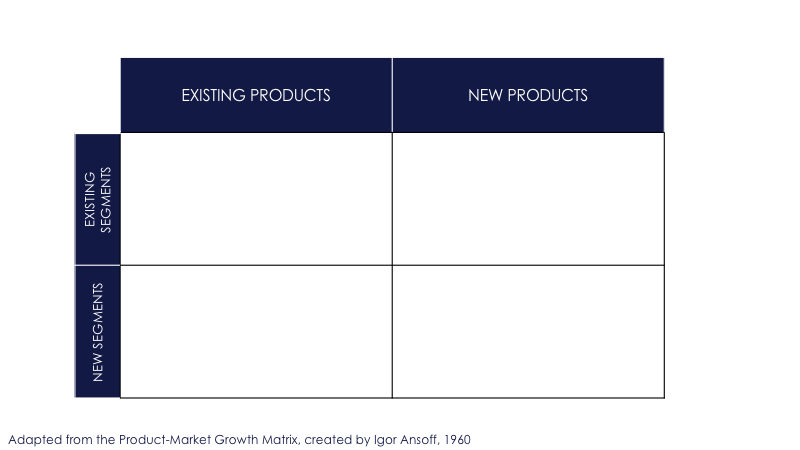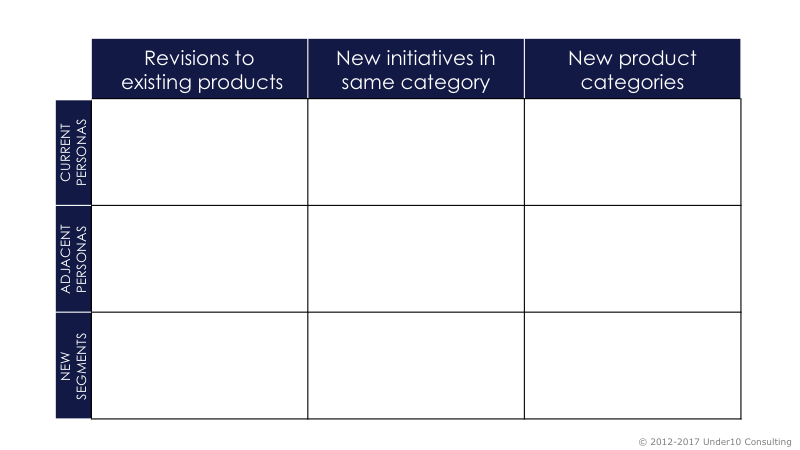Prioritizing for Strategic Alignment

One of the questions we tackle in roadmapping is how an idea aligns with the organization’s strategy and vision—before it hits the roadmap. The Ansoff Matrix is a great tool for determining strategic fit for new product and feature ideas.
Harry Igor Ansoff was a Russian American applied mathematician and business manager. He is known as the father of strategic management. He consulted with hundreds of multinational corporations including Philips, General Electric, IBM, and Westinghouse. Ansoff created a powerful way for looking at strategy, now known as “The Ansoff Matrix.” You may have seen it before. Use it to evaluate some of your project ideas in terms of strategic alignment with your organization.

Many companies stay in the upper-left corner, building revisions and minor updates to their existing set of products for their known set of customers—companies that share a common set of problems and personas. That’s a safe place to be… in the short-term.
To expand, you need to explore adjacent spaces.
For example, a firm could decide to either expand its portfolio of offerings to better support an existing market or instead decide to promote its existing set of offerings to a new market segment. The choice between new product initiatives or new market focus is a strategic decision.
In diversification, an organization tries to grow by introducing new offerings in new markets. It is the most challenging strategy because both product and market development is required.
For software companies, we can extend this matrix a little, cutting the distinctions a bit finer.

For products, think about revisions to existing products, new product initiatives in the same product category, and new product categories, often on technology that is unfamiliar to your team.
For example, consider Apple’s iPad. They could continue to revise the iPad in different sizes and memory configurations. For new initiatives, adding stylus and keyboard makes sense. And you could argue the value of network routers and printers and other things you connect to a tablet. But a move into cars or houses is an entirely new category of product.
As for the rows, some product initiatives are designed for your existing customer personas; others for new personas and or new segments.
Think of salesforce adding new features that help sales people sell. For adjacent personas, salesforce may consider initiatives that benefit marketing or product managers. And finally, they may want to create products for a new market segment—either a specific industry or geographic market.
Obviously the further you get from what you already know—personas and products—the more you’ll need to learn about the new markets and technology. That’s where risk comes into play. And that’s why “LEARN” is at the core of our methodology.
The Ansoff Matrix is a handy tool to explain product strategy to your executive team. And makes for a great discussion for what we should plan to do and what we shouldn’t.
Print this worksheet and discuss which of the boxes are best for your company in the near-term as well as the long-term. It’s unlikely your organization can successfully deliver products in all nine categories—focus on only three or four boxes.
On sticky notes, write down a few product initiatives your company could or should be considering. New products, new options, new personas, new geographies. Put your sticky notes in one or more of these categories.
What you’re looking for is projects that don’t align with the three or four boxes that you’ve chosen.
After all, you can’t do everything. Make sure that what you are doing is aligned with the best strategic direction for your organization.

